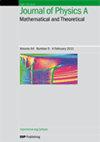Front stability of infinitely steep travelling waves in population biology
IF 2.1
3区 物理与天体物理
Q2 PHYSICS, MATHEMATICAL
Journal of Physics A: Mathematical and Theoretical
Pub Date : 2024-07-21
DOI:10.1088/1751-8121/ad6223
引用次数: 0
Abstract
Reaction–diffusion models are often used to describe biological invasion, where populations of individuals that undergo random motility and proliferation lead to moving fronts. Many reaction–diffusion models of biological invasion are extensions of the well–known Fisher–Kolmogorov–Petrovskii–Piskunov model that describes the spatiotemporal evolution of a 1D population density, , as a result of linear diffusion with flux , and logistic growth source term, . In 2020 Fadai introduced a new reaction–diffusion model of biological invasion with a nonlinear degenerate diffusive flux, , and the model was formulated as a moving boundary problem on , with and at (Fadai and Simpson 2020 J. Phys. A: Math. Theor. 53 095601). Fadai’s model leads to travelling wave solutions with infinitely steep, well–defined fronts at the moving boundary, and the model has the mathematical advantage of being analytically tractable in certain parameter limits. In this work we consider the stability of the travelling wave solutions presented by Fadai. We provide general insight by first presenting two key extensions of Fadai’s model by considering: (i) generalised nonlinear degenerate diffusion with flux for some constant m > 0; and, (ii) solutions describing both biological invasion with , and biological recession with . After establishing the existence of travelling wave solutions for these two extensions, our main contribution is to consider stability of the travelling wave solutions by introducing a lateral perturbation of the travelling wavefront. Full 2D time–dependent level–set numerical solutions indicate that invasive travelling waves are stable to small amplitude lateral perturbations, whereas receding travelling waves are unstable. These preliminary numerical observations are corroborated through a linear stability analysis that gives more formal insight into short time growth/decay of wavefront perturbation amplitude. Julia–based software, including level–set algorithms, is available on Github to replicate all results in this study.群体生物学中无限陡峭行波的前稳定性
反应-扩散模型常用于描述生物入侵,在这种情况下,随机运动和增殖的个体种群会导致移动前沿。许多生物入侵的反应-扩散模型都是著名的 Fisher-Kolmogorov-Petrovskii-Piskunov 模型的扩展,该模型描述了一维种群密度(Ⅳ)的时空演化,是通量(Ⅴ)的线性扩散和对数增长源项(Ⅴ)的结果。2020 年,Fadai 引入了一个新的生物入侵反应-扩散模型,该模型具有非线性退化扩散通量 ,并被表述为一个关于 ,与 和 的移动边界问题(Fadai 和 Simpson 2020 J. Phys. A: Math. Theor. 53 095601)。Fadai 的模型导致了在移动边界上具有无限陡峭、定义明确的前沿的行波解,并且该模型具有在某些参数极限下可分析的数学优势。在这项研究中,我们考虑了 Fadai 提出的行波解的稳定性。我们首先提出了法戴模型的两个关键扩展,从而提供了一般性的见解:(i) 对于某个常数 m > 0,具有通量的广义非线性退化扩散;以及,(ii) 描述生物入侵(Ⅳ)和生物衰退(Ⅴ)的解。在确定了这两种扩展的行波解的存在性之后,我们的主要贡献是通过引入行波面的横向扰动来考虑行波解的稳定性。全二维随时间变化的水平集数值解表明,入侵的行波对小振幅横向扰动是稳定的,而后退的行波是不稳定的。这些初步数值观察结果通过线性稳定性分析得到了证实,从而对波面扰动振幅的短时间增长/衰减有了更正式的了解。Github 上提供了基于 Julia 的软件,包括水平集算法,可用于复制本研究的所有结果。
本文章由计算机程序翻译,如有差异,请以英文原文为准。
求助全文
约1分钟内获得全文
求助全文
来源期刊
CiteScore
4.10
自引率
14.30%
发文量
542
审稿时长
1.9 months
期刊介绍:
Publishing 50 issues a year, Journal of Physics A: Mathematical and Theoretical is a major journal of theoretical physics reporting research on the mathematical structures that describe fundamental processes of the physical world and on the analytical, computational and numerical methods for exploring these structures.

 求助内容:
求助内容: 应助结果提醒方式:
应助结果提醒方式:


